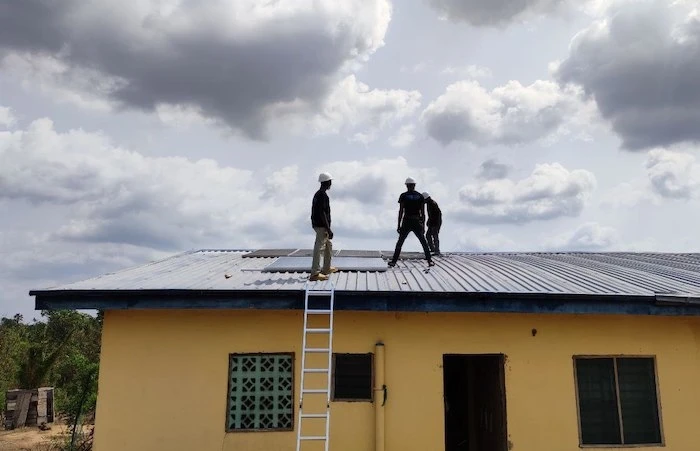& Construction

Integrated BIM tools, including Revit, AutoCAD, and Civil 3D
& Manufacturing

Professional CAD/CAM tools built on Inventor and AutoCAD
Worldwide, more than 700 million people don’t have access to any form of electricity grid, and they often live in remote communities far from urban centers. In these last-mile communities, the challenges of extending the electrical grid often prove insurmountable. The UN’s Sustainable Development Goal 7 would ensure affordable, clean energy for all by 2030 if attained. Goal 7’s success or failure will impact broader economic development and access to crucial services.
Now, an Australian company, Okra Solar, pairs the Internet of Things (IoT) with modular solar power grids to reduce the need for physical infrastructure, potentially propelling this technological package into the lives of people who live off-grid in exceptionally remote areas.
Okra Solar uses a mesh power grid system that connects off-grid homes into a network of rooftop solar and battery systems that can share power intelligently with each other, without needing centralized infrastructure or vast fields of panels. Using this decentralized “mesh grid” approach, the company can provide reliable electricity for a tiny fraction of the cost of extending a traditional grid. To date, Okra Solar has reached more than 1,500 households with clean energy and aims to reach 2 million people by 2025.
“You can install the networks in every single house, even if a house is a kilometer away from the rest of the houses, because it’s a modular system,” says Okra Solar CEO and Founder Afnan Hannan.
A mesh grid system is a hybrid between a mini solar grid and single-home solar applications, offering lower barriers to entry than the former and more power output than the latter. The centralized infrastructure of mini-grid solar systems has higher setup costs, higher operation and maintenance fees, and can take months longer to install. And single-family-home systems don’t generate as much power as mesh grids; the isolation of off-the-grid dwellings means there is little to no reserve power capacity.
Per connection, mesh grids are less expensive and more efficient than micro-grids. “You’re now able to get off-grid households connected at almost half the cost of a traditional mini-grid while giving them the same reliability and availability of power,” Hannan says.
The Okra system uses just a few small hardware units to connect rural, off-grid settlements, starting with roof-mounted solar panels. An artificial intelligence–driven, remote site-mapping tool uses geospatial analysis to find the most efficient arrangement for solar panels across the rooftops of the mesh grid.
The Okra Pod, designed with Autodesk Fusion 360, is the system’s lynchpin hardware. It’s a control unit that manages and distributes the power supply, sending power to multiple houses as demand waxes and wanes for each, whether the mesh grid covers two houses or 200. With batteries installed in each house, the system provides far more flexibility, using excess capacity to deal with elastic electricity demands.
“The pod makes decisions about, ‘This house needs more power than it has access to, so let me draw more from the grid,’” says Oscar Aitchison, product manager for Mesh Grid at Okra Solar. “Or, ‘I have too much power I’m not using, so let me send it out to other houses to charge their batteries up.’”
“If one house is having a wedding, for example, and they need to run really high-powered lights and speakers to have a great party, then it will be pulling power from the other households that have excess power available,” Hannan says.
The Pod connects to 2G, 3G, or 4G networks, which are relatively common in remote areas—and can also connect to Wi-Fi via VSAT satellite technology. The Pod’s operations (power distribution, remote monitoring, and mobile billing) are handled by Okra Solar’s smartphone app, Harvest.
Among the many efficiencies that IoT offers, its ability to streamline communication through automation is key for this network. Connecting an off-grid solar network to the IoT provides critical maintenance and infrastructure benefits particular to the developing world. Because the app can troubleshoot issues with the grid’s hardware, the bar for technical expertise is lower, so it’s possible for residents to handle maintenance and repair.
“If a solar panel was not generating power, we could look at our time series data and automatically use some rules to analyze that and send an alert to the maintenance person on the ground to say, ‘Go to this house and fix the wiring on the solar panel,’” Aitchison says. “That level of automation is really not possible without IoT.”
And in places where transit infrastructure is sparse and travel times are lengthy, relying on local labor is more than an aspect of economic development. “These areas can take days to access,” Aitchison says. “There are often no roads to these places. It becomes incredibly challenging—and that’s if you have that data in advance—and you have people on the ground in the community who can do small fixes. Then, you don’t need to send people out all the time to figure out what’s going on.”
The mesh grid’s lighter infrastructure is also easier to fix. Without a centralized plot of solar infrastructure from which all power radiates outward, there’s no heavy, dangerous cabling. “Now, you’re only sending a small amount of power—the excess power from one house goes a small distance from one house to the next,” Hannan says. “They’re actually using much thinner cables and much lower voltages. Not only is it easier to install and safer, but you’re saving more than 90% of costs because you use more lightweight cables and infrastructure.”
So far, Okra Solar has focused on developing mesh grids in the Philippines, Haiti, Cambodia, and Nigeria. Okra Solar’s customers are electricity service providers, not individual energy customers—though they also lease household appliances through Harvest, which can defuse the chicken-and-egg scenario of residents having little need for electricity if they don’t have access to the labor-saving home appliances that use it.
A mesh grid also can power a wider array of home appliances. Unlike conventional systems that the industry calls “solar home systems,” Okra’s mesh systems allow for more productive power that can run larger devices: refrigerators, washing machines, pumps, electric cookers, rice mills, air conditioning units, and even telecom towers. These tools offer residents greater opportunities for developing economically and starting businesses to improve their quality of life.
In the Philippines, Aitchison has seen fishing communities expand their economies simply because mesh grids let them run their own refrigerators that can make ice. “Their livelihood is fishing, so they need ice to keep their fish cool and sell it in the market,” he says. “Normally, a lot of these communities pay for huge blocks of ice to be shipped to the community, and they’ll get a block chopped off and pay a very high rate. It’s like a dollar a kilo, which might not sound like a lot to us, but it’s very impactful for them.”
But with grid-powered refrigerators, they no longer need to purchase ice and have also been able to start up new freezer-related businesses. “They’re starting to sell ice cream treats for kids and frozen goods—new foods that people didn't even have access to in the community before,” Aitchison says. “They’re starting new businesses—just from having electricity.”
Zach Mortice is an architectural journalist based in Chicago.
Executive insights
Executive insights
AECO








